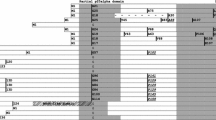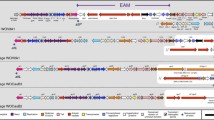Abstract
Apicomplexan parasites contain so-called apicoplasts, which are similar to chloroplasts of red algae. Multiple alignments of the 5′-leader regions of plastid-encoded genes revealed several conserved noncoding regions in parasites as well as in red algae. The regions were assumed to be sites for RNA interactions with regulatory proteins. Conserved sites were found upstream of ycf24, which is required for [Fe-S] cluster development, and several other genes. In particular, a simultaneous regulation was predicted for ycf24, rps4, and rpo B in Toxoplasma gondii. The prediction agreed with the known data that apicoplasts are only required for a short time, but confer pathogenicity on T. gondii. Another site was predicted upstream of rpo B, which encodes the β subunit of RNA polymerase, in red algae Porphyra spp. and parasites Eimeria tenella and Theileria parva.
Similar content being viewed by others
References
Zerges W. 2000. Translation in chloroplasts. Biochimie. 82, 583–601.
Nickelsen J. 2003. Chloroplast RNA-binding proteins. Curr. Genet. 43, 392–399.
Seliverstov A.V., Lyubetsky V.A. 2006. Translation regulation of intron containing genes in chloroplasts. J. Bioinformat. Comput. Biol. 4, 783–793.
Lemieux C., Otis C., Turmel M. 2007. A clade uniting the green algae Mesostigma viride and Chlorokybus atmophyticus represents the deepest branch of the Streptophyta in chloroplast genome-based phylogenies. BMC Biology. 5, 1–17.
Balashov Yu.S. 1998. Iksodovye kleshchi — parazity i perenoschiki infektsii (Ixodid Ticks: Parasites and Infection Vectors), St. Petersburg: Nauka.
Beyer T.V. 1992. Opportunistic infections of protozoan nature. Tsitologiya. 34, 26–27.
Brayton K.A., Lau A.O.T., Herndon D.R., et al. 2007. Genome sequence of Babesia bovis and comparative analysis of apicomplexan hemoprotozoa. PLoS Pathogens. 3, e148.
Zhu G., Marchewka M.J., Keithly J.S. 2000. Cryptosporidium parvum appears to lack a plastid genome. Microbiology. 146, 315–321.
Rangachari K., Davis C.T., Eccleston J.F., Hirst E.M.A., Saldanha J.W., Strath M., Wilson R.J.M. 2002. SufC hydrolyzes ATP and interacts with SufB from Thermotoga maritima. FEBS Letters. 514, 225–228.
Eccleston J.F., Petrovic A., Davis C.T., Rangachari K., Wilson R.J.M. (Iain). 2006. The kinetic mechanism of the SufC ATPase. J. Biol. Chem. 281, 8371–8378.
Vollmer M., Thomsen N., Wiek S., Seeber F. 2001. Apicomplexan parasites possess distinct nuclear-encoded, but Apicoplast-localized, plant-type ferredoxin-NADP+ reductase and ferredoxin. J. Biol. Chem. 276, 5483–5490.
Thomsen-Zieger N., Schachtner J., Seeber F. 2003. Apicomplexan parasites contain a single lipoic acid synthase located in the plastid. FEBS Letters. 547, 80–86.
Muro-Pastor M.I., Florencio F.J. 2003. Regulation of ammonium assimilation in cyanobacteria. Plant Physiol. Biochem. 41, 595–603.
Thompson J.D., Gibson T.J., Plewniak F., Jeanmougin F., Higgins D.G. 1997. The ClustalX windows interface: Flexible strategies for multiple sequence alignment aided by quality analysis tools. Nucleic Acids Res. 25, 4876–4882.
Xu X.M., Adams S., Chua N.-H., Moller S.G. 2005. AtNAP1 represents an atypical SufB protein in Arabidopsis plastids. J. Biol. Chem. 280, 6648–6654.
Wilson R.J.M. (Iain), Rangachari K., Saldanha J.W., Rickman L., Buxton R.S., Eccleston J.F. 2003. Parasite plastids: Maintenance and functions. Phil. Trans. R. Soc. Lond. B. 358, 155–164.
Mazumdar J., Wilson E.H., Masek K., Hunter C.A., Striepen B. 2006. Apicoplast fatty acid synthesis is essential for organelle biogenesis and parasite survival in Toxoplasma gondii. Proc. Nat. Acad. Sci. USA. 103, 13192–13197.
Fleige T., Fischer K., Ferguson D.J.P., Gross U., Bohne W. 2007. Carbohydrate metabolism in the Toxoplasma gondii Apicoplast: localization of three glycolytic isoenzymes, the single pyruvate dehydrogenase complex, and a plastid phosphate translocator. Eucaryotic Cell. 6, 984–996.
Passador L., Linn T. 1992. An internal region of rpoB is required for autogenous translational regulation of the subunit of Escherichia coli RNA polymerase. J. Bacteriol. 174, 7174–7179.
Author information
Authors and Affiliations
Corresponding author
Additional information
Original Russian Text © T.A. Sadovskaya, A.V. Seliverstov, 2009, published in Molekulyarnaya Biologiya, 2009, Vol. 43, No. 4, pp. 599–604.
Rights and permissions
About this article
Cite this article
Sadovskaya, T.A., Seliverstov, A.V. Analysis of the 5′-leader regions of several plastid genes in protozoa of the phylum apicomplexa and red algae. Mol Biol 43, 552–556 (2009). https://doi.org/10.1134/S0026893309040037
Received:
Accepted:
Published:
Issue Date:
DOI: https://doi.org/10.1134/S0026893309040037




